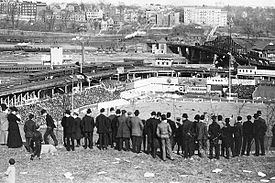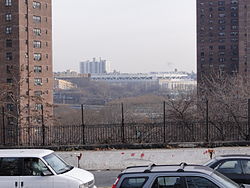- Coogan's Bluff
-
- For the Clint Eastwood movie see Coogan's Bluff (film)
Coogan's Bluff is the name of a promontory located in upper Manhattan in New York City, starting at 155th Street. Rising abruptly from the Harlem River, it is colloquially regarded as the boundary between the neighborhoods of Harlem and Washington Heights.
Yankee Stadium from the bottom of Coogan's Bluff
The bluff overlooks the former site of the Polo Grounds, where Major League Baseball's New York Giants played their home games prior to their move to San Francisco after the end of the 1957 season; as a result, the name "Coogan's Bluff" was often used, particularly by journalists, to denote the Polo Grounds itself, much the same way "China Basin" is frequently used today to refer to AT&T Park in San Francisco, the latter being located therein. However, the ballpark sat in Coogan's Hollow, the bottomland beneath the bluff. The John T. Brush Stairway down Coogan's Bluff is one of the few remaining parts of the Polo Grounds, which is now occupied by the Polo Grounds Towers housing complex.[1][2]
The Morris-Jumel Mansion, the oldest house in Manhattan still standing (built in 1765 and now a museum) is located nearby, and immediately to the west is Sugar Hill, the locality immortalized by Duke Ellington and Billy Strayhorn in their 1941 classic song Take the "A" Train.
Coogan's Bluff is named for real estate owner James J. Coogan (1845-1915), who was elected as Manhattan Borough President in 1898 and served one two-year term in the office. His wife inherited the property and the land was referred to as "Coogan's Bluff" as early as 1893.[3][4]
External links
References
- ^ "Miller's Homer Beats Phillies". The New York Times: p. 8. July 9, 1913. http://query.nytimes.com/gst/abstract.html?res=940DE6DB153FE633A2575AC0A9619C946296D6CF. Retrieved 2009-10-23.
- ^ Williams, Timothy (February 19, 2008). "A Stairway to Sports History From the Polo Grounds". The New York Times. http://cityroom.blogs.nytimes.com/2008/02/19/a-stairway-to-sports-history-from-the-polo-grounds/. Retrieved 2009-10-23.
- ^ Pollak, Michael (April 25, 2004). "F.Y.I.". The New York Times. http://www.nytimes.com/2004/04/25/nyregion/fyi-336211.html. Retrieved 2009-10-25.
- ^ "The Orange Above the Blue". The New York Times: p. 1. December 1, 1893. http://query.nytimes.com/gst/abstract.html?res=9A05EFD6103BEF33A25752C0A9649D94629ED7CF. Retrieved 2009-10-25.
Categories:- Neighborhoods in Manhattan
Wikimedia Foundation. 2010.



